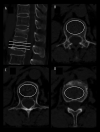Risk Factors for New Vertebral Compression Fracture After Percutaneous Vertebral Augmentation: A Retrospective Study
- PMID: 37461206
- PMCID: PMC10362804
- DOI: 10.12659/MSM.940134
Risk Factors for New Vertebral Compression Fracture After Percutaneous Vertebral Augmentation: A Retrospective Study
Abstract
BACKGROUND Percutaneous vertebral augmentation is the mainstream treatment of osteoporotic vertebral compression fracture (OVCF). New vertebral compression fracture (NVCF) after percutaneous vertebral augmentation may be an issue that cannot be ignored. Nevertheless, the risk factors for NVCF are still uncertain. This research aimed to study the risk factors for NVCF after percutaneous vertebral augmentation. MATERIAL AND METHODS All patients who underwent percutaneous vertebral augmentation for OVCF from January 2019 to December 2020 were enrolled in the study. These patients were divided into NVCF and control groups according to whether they had NVCF. The covariates including sex, age, BMI, diabetes, hypertension, smoking, alcohol, fracture level, surgical method, cement leakage, cement volume, preoperative anterior vertebral height ratio, and Hounsfield unit (HU) value were reviewed. Univariate and multivariate analyses were performed to identify risk factors. RESULTS A total of 279 patients were included in this study, of which 47 had NVCF after percutaneous vertebral augmentation. Univariate analysis demonstrated that there were significant differences in age (OR=1.040, 95% CI=1.003-1.078, P=0.033), BMI (OR=0.844, 95% CI=0.758-0.939, P=0.002) and HU value (OR=0.945, 95% CI=0.929-0.962, P<0.001) between the 2 groups. Multivariate regression analysis revealed that HU value (OR=0.942, 95% CI=0.924-0.960, P<0.001) were independent risk factor for NVCF after percutaneous vertebral augmentation. CONCLUSIONS Hounsfield unit value was an independent risk factor for new vertebral compression fracture after percutaneous vertebral augmentation, whereas age and BMI were not.
Conflict of interest statement
Figures
Similar articles
-
Risk factors of new vertebral compression fracture after percutaneous vertebroplasty or percutaneous kyphoplasty.Front Endocrinol (Lausanne). 2022 Aug 31;13:964578. doi: 10.3389/fendo.2022.964578. eCollection 2022. Front Endocrinol (Lausanne). 2022. PMID: 36120447 Free PMC article.
-
Establishment and Verification of a Predictive Nomogram for New Vertebral Compression Fracture Occurring after Bone Cement Injection in Middle-Aged and Elderly Patients with Vertebral Compression Fracture.Orthop Surg. 2023 Apr;15(4):961-972. doi: 10.1111/os.13655. Epub 2023 Jan 31. Orthop Surg. 2023. PMID: 36718651 Free PMC article.
-
Percutaneous kyphoplasty and risk factors for new vertebral compression fractures: The role of bone quality and paraspinal muscle degeneration.Medicine (Baltimore). 2025 Aug 29;104(35):e44096. doi: 10.1097/MD.0000000000044096. Medicine (Baltimore). 2025. PMID: 40898458 Free PMC article.
-
Balloon kyphoplasty versus percutaneous vertebroplasty for osteoporotic vertebral compression fracture: a meta-analysis and systematic review.J Orthop Surg Res. 2018 Oct 22;13(1):264. doi: 10.1186/s13018-018-0952-5. J Orthop Surg Res. 2018. PMID: 30348192 Free PMC article.
-
[Research progress of secondary fracture of adjacent vertebral body after percutaneous vertebroplasty and percutaneous kyphoplasty].Zhongguo Xiu Fu Chong Jian Wai Ke Za Zhi. 2013 Mar;27(3):369-73. Zhongguo Xiu Fu Chong Jian Wai Ke Za Zhi. 2013. PMID: 23672143 Review. Chinese.
Cited by
-
External validation of predictive models for new vertebral fractures following percutaneous vertebroplasty.Eur Spine J. 2024 May 7. doi: 10.1007/s00586-024-08274-x. Online ahead of print. Eur Spine J. 2024. PMID: 38713446
-
Risk factors for new vertebral fracture after percutaneous vertebroplasty or kyphoplasty for osteoporotic vertebral compression fractures (OVCFs): an updated systematic review and meta-analysis.Eur Spine J. 2025 Jul 14. doi: 10.1007/s00586-025-09082-7. Online ahead of print. Eur Spine J. 2025. PMID: 40658230
-
The reduced cortical bone density in vertebral bodies: risk for osteoporotic fractures? Insights from CT analysis.J Orthop Surg Res. 2024 Aug 17;19(1):486. doi: 10.1186/s13018-024-04896-5. J Orthop Surg Res. 2024. PMID: 39152470 Free PMC article.
-
A novel unilateral extrapedicular approach applied to percutaneous vertebral augmentation to treat thoracic and lumbar Osteoporotic Vertebral Compression Fracture: a retrospective study.BMC Musculoskelet Disord. 2024 Oct 30;25(1):868. doi: 10.1186/s12891-024-07980-3. BMC Musculoskelet Disord. 2024. PMID: 39478520 Free PMC article.
-
Vertebral CT Hounsfield units in postmenopausal women with osteoporotic vertebral compression fracture: identification and validation of reference intervals.Eur Spine J. 2025 May;34(5):1663-1672. doi: 10.1007/s00586-025-08828-7. Epub 2025 Apr 3. Eur Spine J. 2025. PMID: 40175644
References
-
- Johnell O, Kanis JA. An estimate of the worldwide prevalence and disability associated with osteoporotic fractures. Osteoporos Int. 2006;17(12):1726–33. - PubMed
-
- Bliuc D, Nguyen ND, Milch VE, et al. Mortality risk associated with low-trauma osteoporotic fracture and subsequent fracture in men and women. JAMA. 2009;301:513–21. - PubMed
-
- Kamei S, Noguchi T, Shida Y, et al. The safety and efficacy of percutaneous vertebroplasty for patients over 90 years old. Jpn J Radiol. 2019;37(2):178–85. - PubMed
-
- Clark W, Bird P, Gonski P, et al. Safety and efficacy of vertebroplasty for acute painful osteoporotic fractures (VAPOUR): A multicentre, randomised, double-blind, placebo-controlled trial. Lancet. 2016;388:1408–16. - PubMed
-
- Sun HB, Jing XS, Shan JL, et al. Risk factors for pulmonary cement embolism associated with percutaneous vertebral augmentation: A systematic review and meta-analysis. Int J Surg. 2022;101:106632. - PubMed
MeSH terms
Substances
LinkOut - more resources
Full Text Sources
Medical


